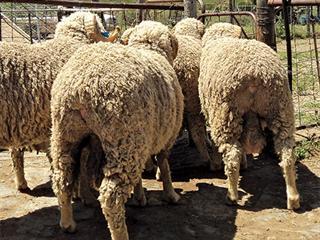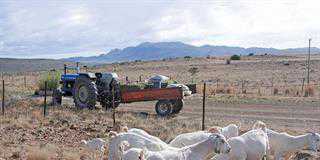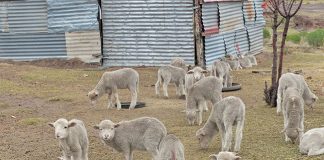
Early feeding has an influence on wool characteristics, so before buying new rams, it’s important to establish how they were raised. Were they adequately fed and all treated in the same way? You should also have a good idea of the type of ram that will do best in your area. Ask yourself: should it have fine wool with loose, open fleeces on plain bodies (no neck folds), or should the wool be stronger and packed a bit more tightly?
When in doubt, consult the locals. If you’re farming under harsh conditions, for example, it might be better to avoid very fine wool rams with open fleeces, as the wool could break and collect dust. Whatever type of ram you decide on, it’s necessary to go through a proper selection process, comparing individual rams with others in their group or price range. This means inspecting their bodies from head to tail as well as opening up and ‘reading’ their fleeces at specific points to compare economically important characteristics such as fibre diameter, amount of wool, clean yield, length, uniformity and general quality.
This is known as the hand-and-eye selection method. Rams can also be selected on the basis of scientifically measured data printed out in performance records or expressed as breeding values. Many buyers use a combination of both methods. Here are some points experienced buyers pay attention to when visually inspecting rams:
General appearance
The ram should be healthy and robust, with each body part in balance, and it should walk easily. The head should have a masculine appearance with a strong, wide mouth and the horns not too close to the face. Testicles must be sound. There should be no black spots on the face or ears, and the facial cover should have a soft look and feel. Look out for marked differences between it and other rams in the group, such as a longer body or shorter legs.
Fleece
Take note when opening the fleece with your thumbs and forefingers. If the staples are difficult to part, the ram might be carrying too much wool. On the other hand, if they are very open and loose, the ram might have too little wool. Look out too, for sparseness of wool on the belly – a so-called creeping belly.
Preferred rams
After you have given all the rams in the group a once-over, pull out those you like and forget the rest. Compare the preferred rams in terms of body conformation, wool length, microns (fineness), density, uniformity of fleece and clean yield. Although the wool must not be too dry, watch out for too much oil or yellow wool. Look for quality fleeces that have well-formed staples with a soft feel and well-defined crimp. Select the rams that show the least variation in microns as you open their fleeces, starting at the neck and shoulder and moving backwards. Normally, the further apart the crimps, the stronger the wool.
Ratio
Your final selection should consist of four or five rams that look alike. Remember that although you can probably get by with fewer rams if you’re using a simple veld mating system, it’s safer to have four rams for every 100 ewes, just in case one or more are infertile or inactive, become injured or die.
Roelof Bezuidenhout is a freelance agricultural writer and a fourth-generation Karoo small-stock farmer specialising in Merino and Dorper sheep and Angora goats.













